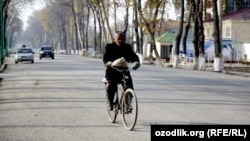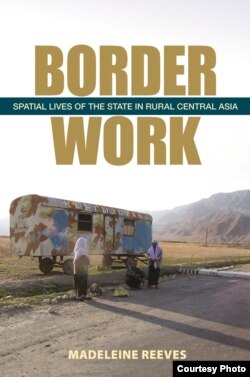
Once again Qishloq Ovozi is pleased to present not one, but two, of the up-and-coming authorities in the field of Central Asian studies. Till Mostowlansky reviews the new book by Madeleine Reeves about one of Central Asia's "hot spots" in the Ferghana Valley. I know, and have great respect, for both Till and Madeleine. Both have lived in Central Asia and conducted extensive fieldwork there, and both are members of the Central Eurasian Scholars and Media Initiative.
In the course of the past year, reports of violent clashes and shoot-outs at the Tajik-Kyrgyz border in Central Asia's Ferghana Valley have frequently featured in the news. Since many readers are unaccustomed with the politics of Central Asia, to them the conflict appears as strange and far off. An image of a region ripe with irrational struggle and ethnic strife has been created. At the same time, media coverage has mainly shied away from the questions of why such events happen and what this actually means for day-to-day life in the Ferghana Valley. In her book "Border Work: Spatial Lives of the State in Rural Central Asia," Madeleine Reeves explores possible answers to these questions, based on a decade of anthropological field research.
Reeves's monograph focuses on the borderland of Kyrgyzstan, Tajikistan, and Uzbekistan at the southern edge of the Ferghana Valley. Marked by enclaves and undefined sections of the frontier, this region is the starting point for a sharp analysis of "border work" -- a term the author employs to describe "the messy, contested and often intensely social business of making territory 'integral.'" (6) At the same time, Reeves also aspires to go beyond the particular case of the Ferghana Valley and to contribute to the global study of borders.
The book manages to meet these high expectations due to its historical and contemporary profoundness. Analysts of Central Asia often locate the source of border conflicts either in the (Soviet) past or the (post-Soviet) present. In contrast, "Border Work" clearly shows that understandings of what borders are and what they are supposed to do have been and are constantly changing. Reeves' critical review of the historical standard narrative of the Central Asian republics' territorial delimitation in the 1920s is a prime example. From this perspective Soviet border drawing in the Ferghana Valley happened in the early period of the union and came to an end in 1927. However, Reeves argues that such border-moving and delimitation actually happened throughout the 20th century and has continued to happen since the dissolution of the Soviet Union. In concrete terms this means that particular (border) conflicts in the Ferghana Valley have their specific histories which can be very recent.
Taking one of these small-scale conflicts in the border zone of Kyrgyzstan, Tajikistan, and Uzbekistan as an example, Reeves manages to trace and follow the genealogy of a specific event into intimate parts of everyday life in the region. This particular conflict began to evolve in spring 2005 when two Tajik school boys from a village at the southern limit of the Sokh enclave (belonging to Uzbekistan) got badly beaten by Kyrgyz border guards. The boys had taken their cattle across the invisible border with Kyrgyzstan due to a lack of pastures on their side. After having caught them without documentation, the Kyrgyz border guards taught the boys a brutal lesson for having illegally entered Kyrgyzstan. Soon after, an ethnicised conflict involving Tajiks and Kyrgyz on both sides of the border emerged.
Such an event shows that a hardly noticeable border, which cuts through customary access to water and land, is prone to being contested. It also emphasises that ordinary people are involved and are actively constructing and challenging what politicians and planners once defined as a border. Reeves therefore suggests that we take local people's experiences of arbitrary border enforcement seriously and move away from the idea that better delimitation will also bring more security. In contrast, she maintains that the densely intertwined lives of the border population should be considered in order to establish trans-boundary peace.
The strength of Reeves' argument lies in the fact that she has the ability and willingness to connect ethnographic details from the Ferghana Valley with broader narratives of Central Asian statehood and beyond. This approach makes reading her book a pleasurable and inspiring endeavour exactly because the reader gets an idea of how complex states function in Central Asia, but also more generally. At the same time, she presents a theoretical framework that prevents the reader from getting lost in the multifariousness of ethnography.
Reeves' insistence on looking at the gaps "both in the border fence, and between 'law' and 'life'" (242) renders this study a recommendable read for scholars, policy-makers, NGO workers, and travellers of the Ferghana Valley alike. Against such a backdrop, Central Asian borders and the conflicts that surround them are neither far distant events nor simply "a post-Soviet curiosity" (243). Thus, if anthropologists, as it is sometimes said, should not only be critical scholars but also journalists and balanced advisers, then this is anthropology at its best.
-- Till Mostowlansky








